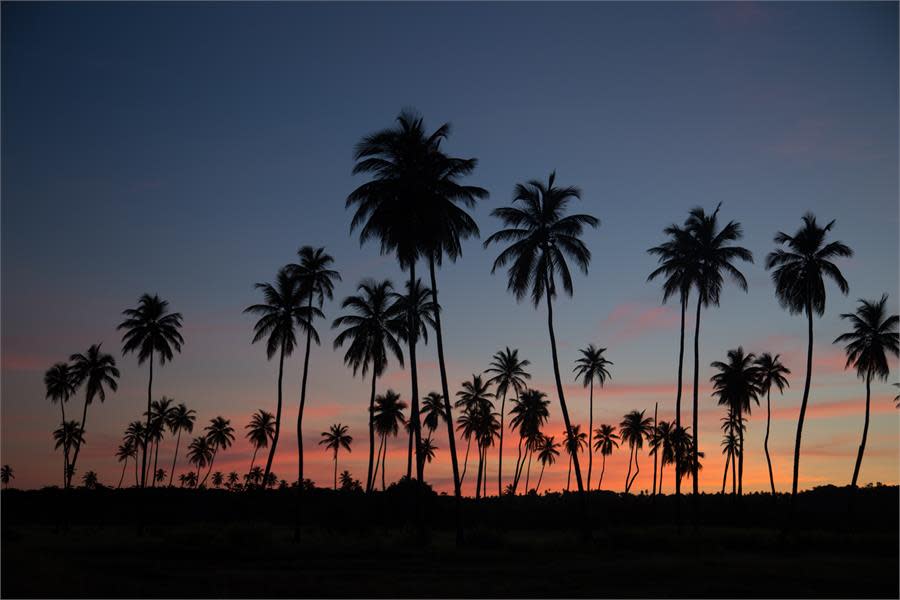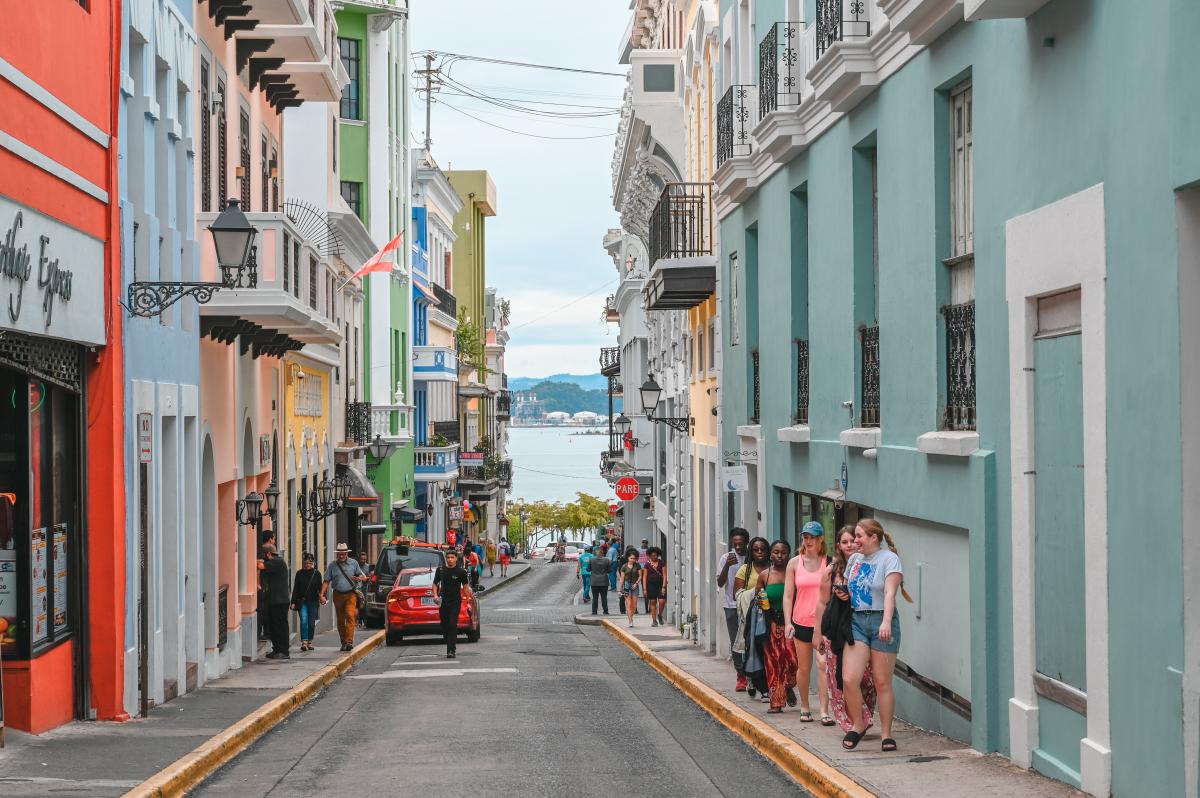By Bill Malcolm*
Beaches, great food, a friendly welcoming culture, and lots to see and do in a city founded 500 years ago make San Juan, Puerto Rico perfect for a holiday. For U.S. citizens, it’s so easy: no passport needed, your phone and phone plan work, and most people speak English as well as Spanish. Did I mention the good coffee and rum?
I was in town for the 40th Anniversary Convention of the International LGBTQ+ Travel Association (IGLTA) along with 700 other travel professionals. Among the many panels, one discussed how to make the Caribbean islands more welcoming to the LGBTQ+ community. Details at igltaconvention.org.
GETTING THERE
I took Southwest to San Juan (SJU) via Fort Lauderdale on the way there and Orlando on the way back. I hopped on an earlier flight on the way back thanks to their new free stand-by policy. JetBlue is also an extremely popular choice to get to the island.
WHERE TO STAY

Image Credit: Courtyard Isla Verde Beach Resort
I stayed at IGLTA member Coqui Del Mar Guest House in Ocean Beach (2218 Calle General Del Valle). The lodge features a great cooked to order breakfast with a side of fresh local fruit (and fresh tropical juices), as well as Puerto Rican coffee, which is quite strong.
A pool and hot tub plus free use of several bicycles also makes for a great visit. On weekends they serve brunch, which was homemade paella the Saturday I was there. They offer tours of Old Town as well as El Yunque National Forest. You can walk or bike to nearby Ocean Park Beach. Details at coquidelmar.com. The property also has VRBO rentals nearby.
Other lodging options include the chain hotels in the Condado district as well as the LGBTQ+ friendly Tryst Beachfront Hotel, which sits right on the beach. The Miramar neighborhood includes the Don Rafa Boutique Hotel, which has a nice bar in the lobby and is in a cute neighborhood with a lot of shops. The Fairmont El San Juan Hotel in Isla Verde near the airport also features a casino, several pools, and a fun bar. Be sure and be on the lookout for resort fees and other charges (aka destination fees, property fees, etc.). They vary widely but many hotels now have them and not just here.
WHAT TO DO
 Image Credit: Unsplash
Image Credit: Unsplash
San Juan is a city of historic, interesting, and colorful safe neighborhoods and I explored many of them. The Condado neighborhood is right on the beach and has interesting shops and many higher-end hotels. The beach is beautiful and features an LGBTQ+ section (Atlantic Beach). You can rent chairs right on the beach.
The nearby Santurce neighborhood is up and coming. Stroll down Calle Loíza for the most popular cafes, galleries, and murals. The Santurce Mercado is a farmer’s market in the up and coming arts district of Santurce, which is known for a lot of murals.
Old San Juan was the highlight of my entire trip and focuses on this area founded in 1508 by Juan Ponce de León. I took a walking tour of the LGBTQ+ monuments with Puerto Rico Gay Tours (www.PuertoRicoGayTours.com), which focused on historic Old San Juan.
You will also want to visit Fort Morro (Castillo San Felipe del Morro) in Old San Juan, now run by the U.S. National Park Service. Built in 1539 by the Spaniards to fortify San Juan, they needed the Island for supplies for ships en route to the Americas from Europe and Africa. El Morro was built to protect San Juan Bay’s deep harbor from attack by the sea and sits at the end of the city which also had a wall built around it. The Spaniards ruled until 1898 when Puerto Rico became a U.S. territory.
The Distrito T Mobile near the Puerto Rico Convention Center is the new entertainment and dining destination. They had La Bamba dancers at the opening night of IGLTA’s Global Convention when I was there.
 Image Credit: Unsplash
Image Credit: Unsplash
Río Piedras is another neighborhood to visit. I took the Tren Urbano (metro or subway) to the Río Piedras neighborhood for lunch at the Plaza del Mercado (farmer’s market) and had a fresh juice smoothie (papaya, guava, pineapple, coconut) and a meat roll. A local band played while a dancer accompanied them at the Plaza.
Nearby is the beautiful University of Puerto Rico campus which features Spanish architecture and lots of tropical trees. The Spanish architecture reminded me of the Stanford University Campus in California.
I then took the metro out to the last station, Bayamón, and walked around this historic suburban city which is over 250 years old. Day passes are just US$5. It is a perfect way to explore the area. Have something to eat or drink at the food trucks, which are parked in shipping containers. There are two small museums in the suburban village, which is very walkable. The train system is safe, modern and graffiti free.
San Juan is a city of historic, interesting, and colorful safe neighborhoods and I explored many of them. The Condado neighborhood is right on the beach and has interesting shops and many higher end hotels. The beach is beautiful and features a gay section (Atlantic Beach). You can rent chairs right on the beach. Plan on a day at the beach.
The nearby Santurce neighborhood is up and coming. Stoll down Calle Loiza for the most popular cafes, galleries, and murals. The Santurce Mercardo is a farmer’s market in this up and coming arts district of Santtucre which is known for a lot of murals. Buy a Puerto Rican hat at the hat store.
Old San Juan is the highlight of my entire trip and focuses on this area founded in 1508 by Ponce de Leon. I took a walking tour of the gay monuments of Puerto Rico Gay Tours (www.PuertoRicoGayTours.com) which focused on historic Old San Juan.
NIGHTLIFE

Image Credit: Discover Puerto Rico
San Juan has the best nightlife in the Caribbean. Tia Maria’s in the Santurce neighborhood is a lot of fun and features a friendly local crowd. Oasis is close to the LGBTQ+ beach in the Condado neighborhood right on the beach. Head to La Placita, the Santruce fruit market by day.
WHERE AND WHAT TO EAT
 Image Credit: Unsplash
Image Credit: Unsplash
Lots of food options with interesting dishes define this city.
For a splurge, Marmalade Restaurant in Old San Juan features fourteen-course meals. The beef tenderloin was excellent. Nearby I also had a rum cocktail at La Factoria (148 Calle San Sebastian).
While in Puerto Rico, enjoy the local fruits (mango, papaya, pineapple, coconut). The bread is particularly good. Rice and beans are a staple. Many restaurants also feature paella (the Spanish rice dish with seafood and vegetables). Expect a lot of Island spices including cilantro in many dishes.
Bacardi makes rum right on the Island and the Pina Colada was invented here. Rum is produced from sugar cane, also produced on the island.
For a snack, try local candies like the coconut ginger bar.
TRAVEL TIPS
This is a Spanish-speaking island although most people also use English. Street signs are in Spanish. They use the metric system (gas is US$1 a liter) but the speed limits are in miles per hour.
Skip the rental car and take Uber/rideshare. It’s fast and cheap.
Although it sometimes does not feel like it, you are in the U.S. Which is why I liked to “Live Boricua” (live Puerto Rican) referring to the spirit, flavor, and rhythm you will feel in every part of the island. The locals are proud and happy people living on a wonderful island. This was my first visit. but it certainly won’t be my last. This is an easy to visit, LGBTQ+ welcoming tropical paradise that has not been overrun with tourists.
The Discover Puerto Rico website features an LGBTQ section full of travel tips including nightlife ideas.
You owe it to yourself to visit and Live Boricua!
*Bill Malcolm is North America’s only syndicated LGBTQ+ value travel columnist. Featured Image Credit: Discover Puerto Rico